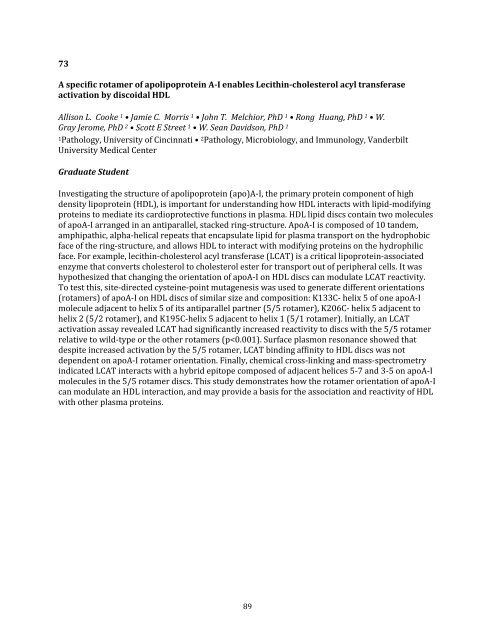2017 Cardiovascular Research Day Abstract Book
Create successful ePaper yourself
Turn your PDF publications into a flip-book with our unique Google optimized e-Paper software.
73<br />
A specific rotamer of apolipoprotein A-I enables Lecithin-cholesterol acyl transferase<br />
activation by discoidal HDL<br />
Allison L. Cooke 1 • Jamie C. Morris 1 • John T. Melchior, PhD 1 • Rong Huang, PhD 1 • W.<br />
Gray Jerome, PhD 2 • Scott E Street 1 • W. Sean Davidson, PhD 1<br />
1Pathology, University of Cincinnati • 2 Pathology, Microbiology, and Immunology, Vanderbilt<br />
University Medical Center<br />
Graduate Student<br />
Investigating the structure of apolipoprotein (apo)A-I, the primary protein component of high<br />
density lipoprotein (HDL), is important for understanding how HDL interacts with lipid-modifying<br />
proteins to mediate its cardioprotective functions in plasma. HDL lipid discs contain two molecules<br />
of apoA-I arranged in an antiparallel, stacked ring-structure. ApoA-I is composed of 10 tandem,<br />
amphipathic, alpha-helical repeats that encapsulate lipid for plasma transport on the hydrophobic<br />
face of the ring-structure, and allows HDL to interact with modifying proteins on the hydrophilic<br />
face. For example, lecithin-cholesterol acyl transferase (LCAT) is a critical lipoprotein-associated<br />
enzyme that converts cholesterol to cholesterol ester for transport out of peripheral cells. It was<br />
hypothesized that changing the orientation of apoA-I on HDL discs can modulate LCAT reactivity.<br />
To test this, site-directed cysteine-point mutagenesis was used to generate different orientations<br />
(rotamers) of apoA-I on HDL discs of similar size and composition: K133C- helix 5 of one apoA-I<br />
molecule adjacent to helix 5 of its antiparallel partner (5/5 rotamer), K206C- helix 5 adjacent to<br />
helix 2 (5/2 rotamer), and K195C-helix 5 adjacent to helix 1 (5/1 rotamer). Initially, an LCAT<br />
activation assay revealed LCAT had significantly increased reactivity to discs with the 5/5 rotamer<br />
relative to wild-type or the other rotamers (p


